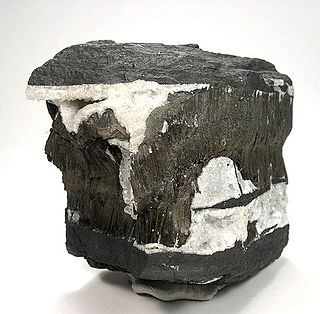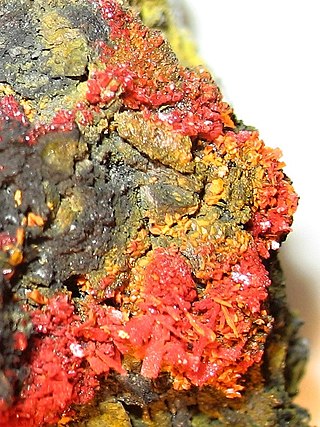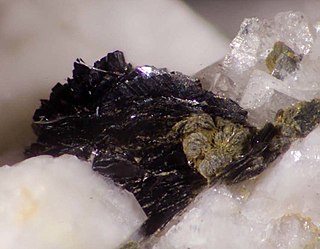Related Research Articles

Mineralogy is a subject of geology specializing in the scientific study of the chemistry, crystal structure, and physical properties of minerals and mineralized artifacts. Specific studies within mineralogy include the processes of mineral origin and formation, classification of minerals, their geographical distribution, as well as their utilization.

Todorokite is a complex hydrous manganese oxide mineral with generic chemical formula (Na,Ca,K,Ba,Sr)
1-x(Mn,Mg,Al)
6O
12·3-4H
2O. It was named in 1934 for the type locality, the Todoroki mine, Hokkaido, Japan. It belongs to the prismatic class 2/m of the monoclinic crystal system, but the angle β between the a and c axes is close to 90°, making it seem orthorhombic. It is a brown to black mineral which occurs in massive or tuberose forms. It is quite soft with a Mohs hardness of 1.5, and a specific gravity of 3.49 – 3.82. It is a component of deep ocean basin manganese nodules.

Afghanite, (Na,K)22Ca10[Si24Al24O96](SO4)6Cl6, is a hydrous sodium, calcium, potassium, sulfate, chloride, carbonate alumino-silicate mineral. Afghanite is a feldspathoid of the cancrinite group and typically occurs with sodalite group minerals. It forms blue to colorless, typically massive crystals in the trigonal crystal system. The lowering of the symmetry from typical (for cancrinite group) hexagonal one is due to ordering of Si and Al. It has a Mohs hardness of 5.5 to 6 and a specific gravity of 2.55 to 2.65. It has refractive index values of nω = 1.523 and nε = 1.529. It has one direction of perfect cleavage and exhibits conchoidal fracture. It fluoresces a bright orange.
Geigerite is a mineral, a complex hydrous manganese arsenate with formula: Mn5(AsO3OH)2(AsO4)2·10H2O. It forms triclinic pinacoidal, vitreous, colorless to red to brown crystals. It has a Mohs hardness of 3 and a specific gravity of 3.05.
Jarosewichite is a rare manganese arsenate mineral with formula: Mn2+3Mn3+(AsO4)(OH)6. It was first described in Franklin, New Jersey which is its only reported occurrence. Its chemical composition and structure are similar to chlorophoenicite. This mineral is orthorhombic with 2/m2/m2/m point group. Its crystals are prismatic or barrel-shaped. The color of jarosewichite is dark red to black. It has subvitreous luster of fracture surfaces and reddish-orange streak. This mineral occurs with flinkite, franklinite, andradite and cahnite.

Alacránite (As8S9) is an arsenic sulfide mineral first discovered in the Uzon caldera, Kamchatka, Russia. It was named for its occurrence in the Alacrán silver/arsenic/antimony mine. Pampa Larga, Chile. It is generally more rare than realgar and orpiment. Its origin is hydrothermal. It occurs as subhedral to euhedral tabular orange to pale gray crystals that are transparent to translucent. It has a yellow-orange streak with a hardness of 1.5. It crystallizes in the monoclinic crystal system. It occurs with realgar and uzonite as flattened and prismatic grains up to 0.5 mm across.

Bararite is a natural form of ammonium fluorosilicate (also known as hexafluorosilicate or fluosilicate). It has chemical formula (NH4)2SiF6 and trigonal crystal structure. This mineral was once classified as part of cryptohalite. Bararite is named after the place where it was first described, Barari in Jharia Coal Field, Dhanbad, India. It is found at the fumaroles of volcanoes (Vesuvius, Italy), over burning coal seams (Barari, India), and in burning piles of anthracite (Pennsylvania, U.S.). It is a sublimation product that forms with cryptohalite, sal ammoniac, and native sulfur.
Bityite is considered a rare mineral, and it is an endmember to the margarite mica sub-group found within the phyllosilicate group. The mineral was first described by Antoine François Alfred Lacroix in 1908, and later its chemical composition was concluded by Professor Hugo Strunz. Bityite has a close association with beryl, and it generally crystallizes in pseudomorphs after it, or in cavities associated with reformed beryl crystals. The mineral is considered a late-stage constituent in lithium bearing pegmatites, and has only been encountered in a few localities throughout the world. The mineral was named by Lacroix after Mt. Bity, Madagascar from where it was first discovered.

Cervandonite is a rare arsenosilicate mineral. It has a chemical formula (Ce,Nd,La)(Fe3+
,Fe2+
,Ti4+
,Al)
3SiAs(Si,As)O
13 or (Ce,Nd,La)(Fe3+
,Fe2+
,Ti,Al)
3O
2(Si
2O
7)(As3+
O
3)(OH). It has a monoclinic crustal structure with supercell (Z=6), the crystal structure was established as a trigonal subcell, with space group R3m and a = 6.508(1)Ǻ, c = 18.520(3) Ǻ, V 679.4(2) Ǻ3, and Z=3. It was first described by Buhler Armbruster in 1988, but it has proven to be problem due to the extreme scarcity of single crystals and its unusual replacement of silicon and arsenic. Cervandonite is named after the location where it was first described, Pizzo Cervandone (Scherbadung), Italy in the Central Alps.
Bystrite is a silicate mineral with the formula (Na,K)7Ca(Si6Al6)O24S4.5•(H2O), and a member of the cancrinite mineral group. It is a hexagonal crystal, with a 3m point group. The mineral may have been named after the Malaya Bystraya deposits in Russia, where it was found.

Cyrilovite (NaFe33+(PO4)2(OH)4·2(H2O)) is a hydrous sodium iron phosphate mineral. It is isomorphous and isostructural with wardite, the sodium aluminium counterpart.

Fluor-uvite is a tourmaline mineral with the chemical formula CaMg3(Al5Mg)(Si6O18)(BO3)3(OH)3F. It is a rare mineral that is found in calcium rich contact metamorphic rocks with increased amounts of boron. Uvite is trigonal hexagonal, which means that it has three equal length axes at 120 degrees, all perpendicular to its fourth axis which has a different length. Uvite is part of the space group 3m. Uvite's hardness has been measured to be 7.5 on the Mohs hardness scale. The color of uvite widely varies, depending on the sample, but is mostly deep green or brown. In regard to uvite's optical properties, it is uniaxial (-) and anisotropic, meaning that the velocity of light in the mineral depends on the path that it takes. In plane polarized light, uvite is colorless to pale yellow and shows weak pleochroism.

Donnayite-(Y) is a rare-earth carbonate mineral containing the rare-earth metal yttrium. It was first discovered in 1978 at Mont Saint-Hilaire, Quebec. Donnayite was subsequently identified and named after Joseph D. H. Donnay and his wife, Gabrielle Donnay. Both were prominent mineralogists and crystallographers, and J. D. H. Donnay was awarded the Roebling Award by the Mineralogical Society of America in 1971 for his emphasis on the importance of optical mineralogy and crystal morphology. Donnayite tends to occur in small quantities in the pegmatite dykes and miarolitic cavities of mountainous regions. It crystallizes in this environment with increasing alkalinity values until the alkalinity suddenly drops during the last stage of crystallization. This results in increasing amounts of Na carbonates and REE minerals. First discovered at Mont St-Hilaire, donnayite has since been found in the Southern Ural Mountains of Russia and the Narssarssuk pegmatite of South Greenland. Donnayite crystals tend to be small and the color is commonly pale yellow to yellow with a white streak and a vitreous luster. Donnayite crystals usually display trigonal or hexagonal symmetry and have a hardness of 3. Twinning is extremely common in this mineral. Minerals closely related to donnayite include synchysite, calcite, sphalerite, microcline, and analcime. Donnayite is isomorphous with weloganite and mckelveyite.
Carlosruizite is a sulfate or selenate–iodate mineral with chemical formula: K6(Na,K)4Na6Mg10(SeO4)12(IO3)12·12H2O. It has a low density (specific gravity of 3.36), colorless to pale yellow, transparent mineral which crystallizes in the trigonal crystal system. It forms a series with fuenzalidaite.
Eveslogite is a complex inosilicate mineral with a chemical formula (Ca,K,Na,Sr,Ba)
48[(Ti,Nb,Fe,Mn)
12(OH)
12Si
48O
144](F,OH,Cl)
14 found on Mt. Eveslogchorr in Khibiny Mountains, on the Kola peninsula, Russia. It was named after the place it was found. This silicate mineral occurs as an anchimonomineral veinlet that cross-cuts poikilitic nepheline syenite. This mineral appears to resemble yuksporite, as it forms similar placated fine fibrous of approximately 0.05 to 0.005mm that aggregates outwardly. The color of eveslogite is yellow or rather light brown. In addition, it is a semitransparent mineral that has a white streak and a vitreous luster. Its crystal system is monoclinic and possesses a hardness (Mohs) of 5. This newly discovered mineral belongs to the astrophyllite group of minerals and contains structures that are composed of titanosilicate layers. Limited information about this mineral exists due to the few research studies carried out since its recent discovery.
Farneseite is a mineral from the cancrinite sodalite group with 14 layer stacking. It is a complex silicate mineral with formula (Na,Ca,K)56(Al6Si6O24)7(SO4)12·6H2O. It was named after a location in Farnese, Lazio, Italy. It is a member of the cancrinite-sodalite group, approved in 2004 as a new mineral species. The group is characterized by the number of stacking layers making up each member, with farneseite being one of newest minerals in the group with a 14 layer stacking structure. It is a clear transparent mineral and has a hexagonal crystal system with crystal class of 6/m and space group of P63/m. The specimens discovered in Farnese were in a pyroclastic rock from the Làtera Cauldera region.

Gordaite is a sulfate mineral composed primarily of hydrous zinc sodium sulfate chloride hydroxide with formula: NaZn4(SO4)(OH)6Cl·6H2O. It was named for the discovery location in the Sierra Gorda district of Chile. Gordaite forms as tabular trigonal crystals.

Serrabrancaite is a mineral with the chemical formula MnPO4•H2O and which is named for the locality where it was found, the Alto Serra Branca Pegmatite. The Alto Serra Branca mine has been in operation since the 1940s. It is located in Paraiba, Brazil near a village named Pedra Lavrada. Tantalite is the main mineral mined here. Specimens of serrabrancaite are kept in the Mineralogical Collections of both the Bergakademie Freiberg, Germany and the Martin-Luther Universität Halle, Institut für Geologische Wissenschaften.

Kosnarite is an alkali zirconium phosphate mineral (KZr2(PO4)3) named after an expert of pegmatites Richard A. Kosnar. Kosnarite contains potassium, oxygen, phosphorus, and zirconium with sodium, rubidium, hafnium, manganese and fluorine (Na, Rb, Hf, Mn, and F) being common impurities found in kosnarite. It was discovered in nature for the first time in 1991 by Vandall T. King. Samples that were found in granitic pegmatites from the Mount Mica Quarry, Paris, Oxford County, Maine, US were sent to Eugene E. Foord for study. This became the first recorded case of naturally occurring kosnarite.
Parascorodite is a rare, secondary iron-arsenate mineral. It has a chemical formula of (FeAsO4·2H2O) and was discovered in 1967 using X-ray powder diffraction methods, when an unknown substance was found along with scorodite on medieval ore dumps in the Czech Republic. The holotype of parascorodite can be found in the mineralogical collection of the National Museum, Prague, Czech Republic under acquisition number P1p25/98.
References
- ↑ Warr, L.N. (2021). "IMA–CNMNC approved mineral symbols". Mineralogical Magazine. 85 (3): 291–320. Bibcode:2021MinM...85..291W. doi: 10.1180/mgm.2021.43 . S2CID 235729616.
- ↑ "Alloriite." Alloriite: Mineral Information, Data and Localities. Mindat.
- ↑ [Chukanov, N.V., Rastsvetaeva, R.K., Pekov, I.V. et al. Geol. Ore Deposits (2007) 49: 752. https://doi.org/10.1134/S1075701507080090]